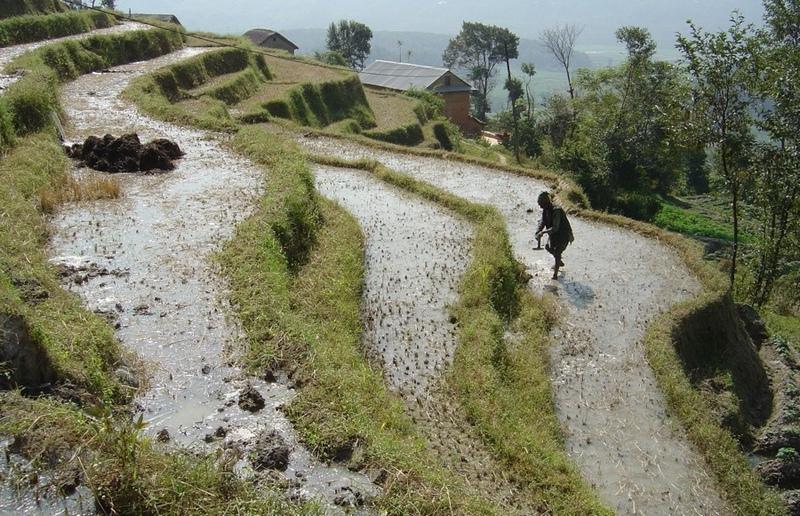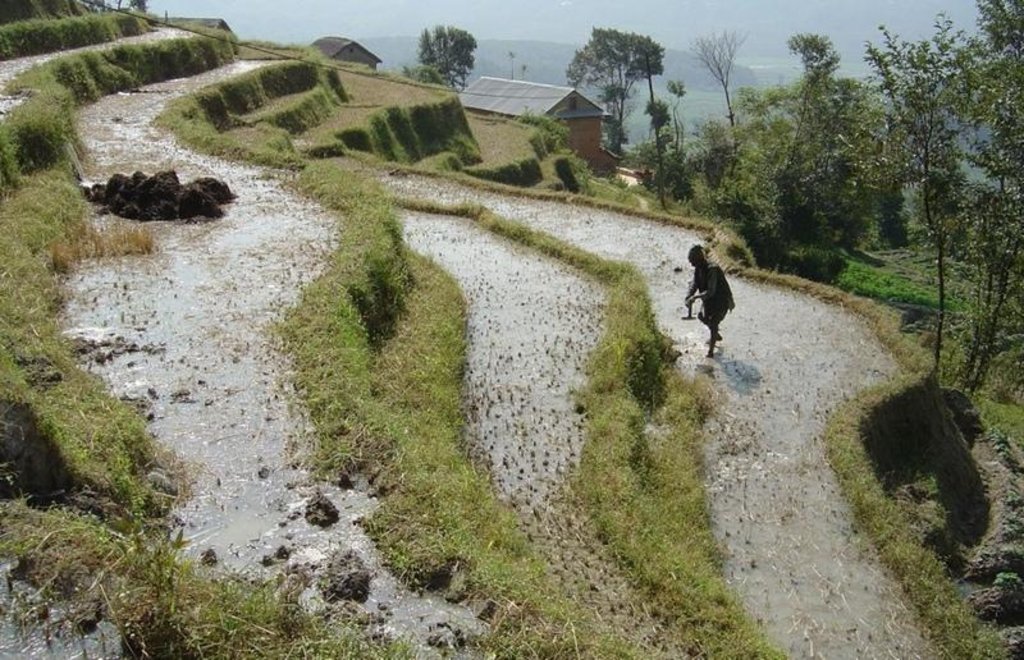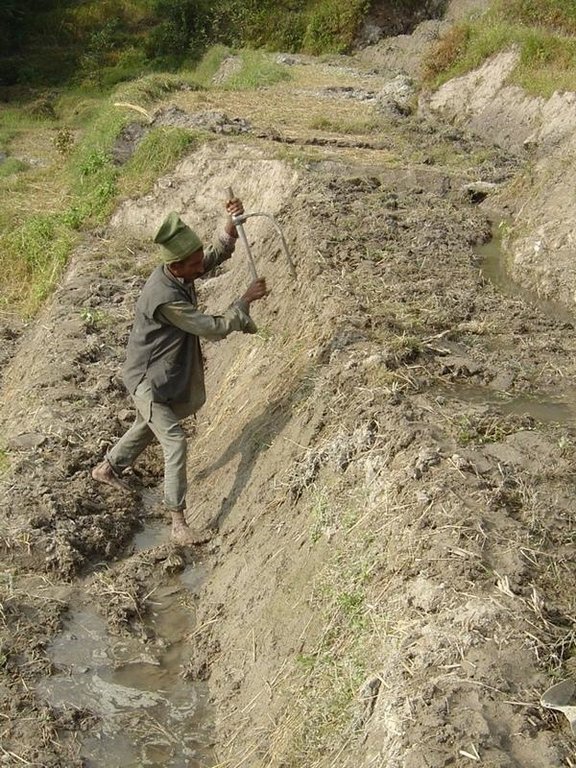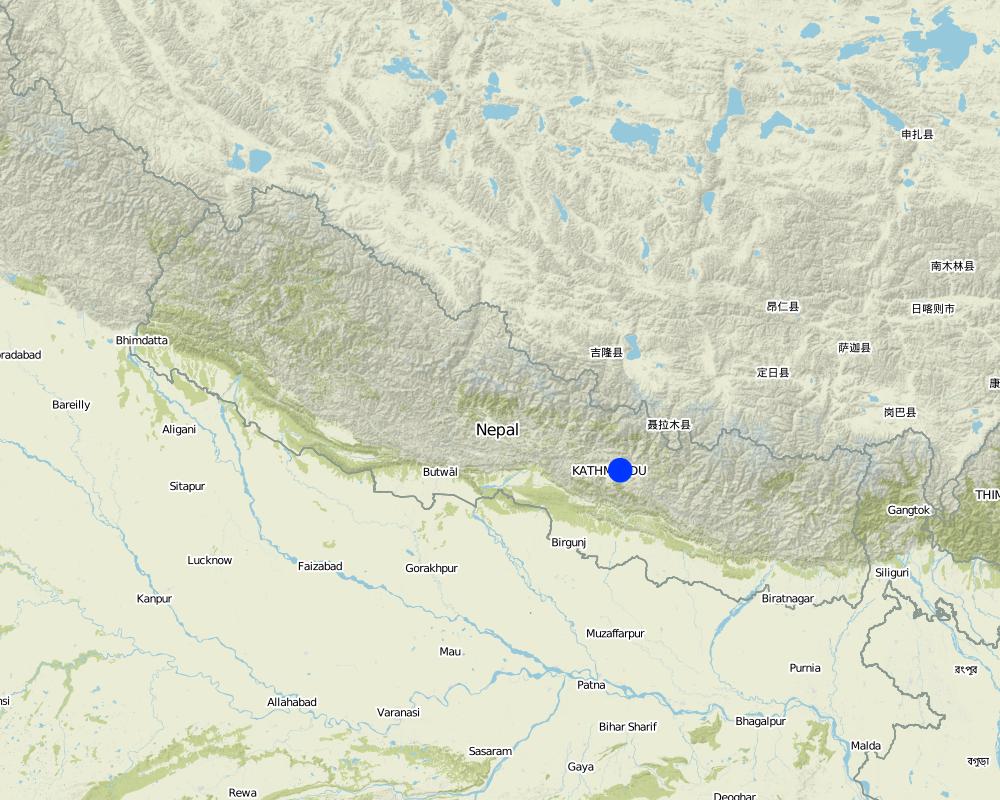Traditional irrigated rice terraces [Nepal]
- Creation:
- Update:
- Compiler: Ramanand Bhattarai
- Editor: –
- Reviewers: David Streiff, Deborah Niggli
Tari khet (Nepali)
technologies_1099 - Nepal
View sections
Expand all Collapse all1. General information
1.2 Contact details of resource persons and institutions involved in the assessment and documentation of the Technology
Key resource person(s)
SLM specialist:
SLM specialist:
1.3 Conditions regarding the use of data documented through WOCAT
When were the data compiled (in the field)?
01/11/2003
The compiler and key resource person(s) accept the conditions regarding the use of data documented through WOCAT:
Yes
2. Description of the SLM Technology
2.1 Short description of the Technology
Definition of the Technology:
Level bench terraces with risers protected by fodder grasses, used for the irrigated production of rice, potatoes and wheat
2.2 Detailed description of the Technology
Description:
The level bench terrace is a traditional technology that makes irrigated crop production possible on steep, erosion prone slopes. The majority of such terraces in Nepal were constructed by hand many generations ago, but some new land - mostly already under rainfed cultivation on forward sloping terraces - is still being converted into irrigated terraces. The initial costs for the construction of the terraces are extremely high – and annual maintenance costs are considerable also. The climate is humid subtropical, slopes are steep (30%-60%) and soils generally have a sandy loam texture. Terraces are cropped by farmers who mostly have less than 0.5 ha of land each.
Two to three annual crops are grown per year starting with paddy rice during the monsoon, followed by potatoes and/or wheat.
While terrace beds are usually 2–6 m in width, to save labour they are made as wide as they can be without increasing the danger of slips/land slides. Surveying was traditionally done by eye, but now a water-tube level may be used. Risers are 0.8-1.5 m high with a small lip (20-25 cm). The slope of the riser varies from 80 to 160%, depending on the initial gradient of the hill. Stones are incorporated in the risers if available, and grass species such as bermuda grass (Cynodon dactylon) and napier (Pennisetum purpureum) may be planted for stabilisation and as cattle fodder. The risers are compacted (with hoes) to improve ponding conditions for the paddy rice. Twice per year the risers are scraped with a special tool: (1) at the time of land preparation for paddy rice the lower part of riser is sliced, but the upper part is left protected with grasses against the monsoon rains; (2) at the time of wheat planting the whole riser (including the lip) is scraped and spread as green manure on the terrace.
Terraces are flooded with water for paddy rice cultivation: a smaller amount of water is diverted into the fields for other crops. Excess water is drained to the lower terrace by openings in the lip, which are filled with rice straw in order to filter out sediments. The depth of water for rice - when flooded completely - is normally between 10 and 15 cm. Fertility is maintained by addition of farmyard manure, spreading the scraped soil from the riser, and also through sediment carried in the irrigation water. Nowadays, mineral fertilizers are also applied.
2.3 Photos of the Technology
2.5 Country/ region/ locations where the Technology has been applied and which are covered by this assessment
Country:
Nepal
Region/ State/ Province:
Kathmandu
Further specification of location:
Manmata subwatershed
Map
×3. Classification of the SLM Technology
3.1 Main purpose(s) of the Technology
- improve production
3.2 Current land use type(s) where the Technology is applied

Cropland
- Annual cropping
Main crops (cash and food crops):
major cash crop: Potatoes
major food crop: Rice and wheat
Comments:
Major land use problems (compiler’s opinion): - steep slopes, not suitable for agriculture in their original state (better for forestry, agroforestry, horticulture, and fruit
trees)
- small and scattered plots of land
- land users find chemical fertilizers and water expensive
- there is water scarcity from September to May and too much rain in the monsoon period (June to August) with the danger of erosion and collapse of the terraces
3.3 Further information about land use
Water supply for the land on which the Technology is applied:
- rainfed
Number of growing seasons per year:
- 2
Specify:
Longest growing period in days: 150 Longest growing period from month to month: Jun - Oct Second longest growing period in days: 120 Second longest growing period from month to month: Nov - Feb
3.4 SLM group to which the Technology belongs
- cross-slope measure
3.5 Spread of the Technology
Specify the spread of the Technology:
- evenly spread over an area
If the Technology is evenly spread over an area, indicate approximate area covered:
- 0.1-1 km2
Comments:
Total area covered by the SLM Technology is 1 sq km2.
3.6 SLM measures comprising the Technology

agronomic measures
- A2: Organic matter/ soil fertility

vegetative measures
- V2: Grasses and perennial herbaceous plants

structural measures
- S1: Terraces
Comments:
Main measures: agronomic measures, vegetative measures, structural measures
Type of agronomic measures: manure / compost / residues, mineral (inorganic) fertilizers
3.7 Main types of land degradation addressed by the Technology

soil erosion by water
- Wt: loss of topsoil/ surface erosion
- Wg: gully erosion/ gullying
- Wm: mass movements/ landslides
Comments:
Main type of degradation addressed: Wt: loss of topsoil / surface erosion, Wg: gully erosion / gullying, Wm: mass movements / landslides
3.8 Prevention, reduction, or restoration of land degradation
Specify the goal of the Technology with regard to land degradation:
- prevent land degradation
4. Technical specifications, implementation activities, inputs, and costs
4.1 Technical drawing of the Technology
Author:
Mats Gurtner
4.2 Technical specifications/ explanations of technical drawing
Layout of irrigated terraces. Openings in the lips drain excess water, grass cover stabilises lips and risers (right). After harvesting of rice, the grass is scraped off the lower part of the risers (left) and spread on the terrace beds
Technical knowledge required for field staff / advisors: high
Technical knowledge required for land users: high
Main technical functions: reduction of slope angle, reduction of slope length, increase / maintain water stored in soil, control of dispersed and concentrated runoff, increase in soil fertility
Secondary technical functions: improvement of ground cover, water harvesting / increase water supply, water spreading
Manure / compost / residues
Material/ species: green/farmyard manure
Vegetative measure: fodder grass at risers
Terrace
Material: earth
4.3 General information regarding the calculation of inputs and costs
Specify how costs and inputs were calculated:
- per Technology area
Indicate size and area unit:
ha
Specify currency used for cost calculations:
- US Dollars
4.4 Establishment activities
| Activity | Type of measure | Timing | |
|---|---|---|---|
| 1. | Planting grasses including bermuda grass (Cynodon dactylon). | Vegetative | during monsoon |
| 2. | Construct bunds (risers) with soil from upper and lower sides | Structural | before monsoon |
| 3. | Level terrace beds (soil moved from upper to lower part of terraces). | Structural | before monsoon |
| 4. | Make lips on edges of terraces | Structural | before monsoon |
| 5. | Compact risers | Structural | before monsoon |
| 6. | Construct irrigation canal | Structural | before monsoon |
| 7. | Make openings in lips for drainage of excess water | Structural | before monsoon |
| 8. | Test-irrigate terrace for accurate levelling | Structural | during monsoon |
| 9. | Plant grasses including Bermuda grass (Cynodon dactylon) | Structural | during monsoon |
| 10. | After 2–3 years: some narrow terraces may be merged to form single, wider terraces | Structural | during monsoon |
4.6 Maintenance/ recurrent activities
| Activity | Type of measure | Timing/ frequency | |
|---|---|---|---|
| 1. | Flood the paddy fields .. | Agronomic | (June/July) / Repeated 3–4 times during |
| 2. | Slice/scrape grass and soil on lower part of risers and spread on terraces | Agronomic | (when flooded, June/July) / |
| 3. | Plant rice and apply mineral fertilizer | Agronomic | (June/July). / |
| 4. | Harvest rice | Agronomic | (October) / |
| 5. | Apply manure (cattle manure), after rice harvest | Agronomic | (October). / |
| 6. | Slice/scrape grass and soil from whole of risers and spread on terraces; repairsmall collapses/slumps in risers | Agronomic | (October/November) / |
| 7. | Pprepare land | Agronomic | (November) / |
| 8. | Apply mineral fertilizer | Agronomic | (November/December). / |
| 9. | Irrigate | Agronomic | Nov. / repeated several times during cultivation |
| 10. | Harvest of potato/wheat | Agronomic | (January-March). / |
| 11. | Planting of rice | Vegetative | June,July / |
| 12. | planting of potatoes, wheat | Vegetative | November / |
| 13. | Repair of small collapses/slumps in risers. | Structural | (Oct./Nov.)/ |
4.7 Costs and inputs needed for maintenance/ recurrent activities (per year)
| Specify input | Unit | Quantity | Costs per Unit | Total costs per input | % of costs borne by land users | |
|---|---|---|---|---|---|---|
| Labour | Labour | ha | 1.0 | 350.0 | 350.0 | 100.0 |
| Equipment | Tools | ha | 1.0 | 5.0 | 5.0 | 100.0 |
| Fertilizers and biocides | Fertilizer | ha | 1.0 | 185.0 | 185.0 | 100.0 |
| Fertilizers and biocides | Compost/manure | ha | 1.0 | 300.0 | 300.0 | 100.0 |
| Total costs for maintenance of the Technology | 840.0 | |||||
Comments:
Machinery/ tools: hoe, spade, baskets, (doko), special tool for scraping
Current establishment costs are very difficult to determine since the majority of the traditional terraces were
established a long time ago. Costs depend closely on the present state of the land (forward sloping terraces or uncultivated) and the need for irrigation canals. Farmers say that construction now could cost up to US$ 10,000 per ha if carried out by hand at full labour cost. The cost given for maintening the terraces (approx. US$ 840 per ha) includes all associated annual crop production costs. In this case study, 100% of the construction costs were borne by land users.
5. Natural and human environment
5.1 Climate
Annual rainfall
- < 250 mm
- 251-500 mm
- 501-750 mm
- 751-1,000 mm
- 1,001-1,500 mm
- 1,501-2,000 mm
- 2,001-3,000 mm
- 3,001-4,000 mm
- > 4,000 mm
Agro-climatic zone
- humid
Thermal climate class: subtropics
5.2 Topography
Slopes on average:
- flat (0-2%)
- gentle (3-5%)
- moderate (6-10%)
- rolling (11-15%)
- hilly (16-30%)
- steep (31-60%)
- very steep (>60%)
Landforms:
- plateau/plains
- ridges
- mountain slopes
- hill slopes
- footslopes
- valley floors
Altitudinal zone:
- 0-100 m a.s.l.
- 101-500 m a.s.l.
- 501-1,000 m a.s.l.
- 1,001-1,500 m a.s.l.
- 1,501-2,000 m a.s.l.
- 2,001-2,500 m a.s.l.
- 2,501-3,000 m a.s.l.
- 3,001-4,000 m a.s.l.
- > 4,000 m a.s.l.
5.3 Soils
Soil depth on average:
- very shallow (0-20 cm)
- shallow (21-50 cm)
- moderately deep (51-80 cm)
- deep (81-120 cm)
- very deep (> 120 cm)
Soil texture (topsoil):
- coarse/ light (sandy)
- medium (loamy, silty)
Topsoil organic matter:
- medium (1-3%)
If available, attach full soil description or specify the available information, e.g. soil type, soil PH/ acidity, Cation Exchange Capacity, nitrogen, salinity etc.
Soil fertility is medium
Soil drainage / infiltration is good because of the geology and soil texture (loam)
5.6 Characteristics of land users applying the Technology
Market orientation of production system:
- mixed (subsistence/ commercial
Off-farm income:
- 10-50% of all income
Individuals or groups:
- individual/ household
Level of mechanization:
- manual work
- animal traction
Indicate other relevant characteristics of the land users:
Off-farm income specification: hired labour (on other farmers’ fields) or as porters
Market orientation of production system: Subsistence (rice/wheat) and commercial (potatoes)
5.7 Average area of land owned or leased by land users applying the Technology
- < 0.5 ha
- 0.5-1 ha
- 1-2 ha
- 2-5 ha
- 5-15 ha
- 15-50 ha
- 50-100 ha
- 100-500 ha
- 500-1,000 ha
- 1,000-10,000 ha
- > 10,000 ha
5.8 Land ownership, land use rights, and water use rights
Land ownership:
- individual, not titled
Land use rights:
- leased
- individual
Comments:
Land use rights: leased (90% of farmers), individual (10%)
6. Impacts and concluding statements
6.1 On-site impacts the Technology has shown
Socio-economic impacts
Production
crop production
fodder production
fodder quality
production area
land management
Comments/ specify:
the technology is a part of a complex farming system
Income and costs
expenses on agricultural inputs
farm income
economic disparities
Comments/ specify:
not everyone has access to land for irrigation
workload
Other socio-economic impacts
Livestock fodder
Socio-cultural impacts
community institutions
SLM/ land degradation knowledge
conflict mitigation
Comments/ specify:
when the agreed and scheduled water extraction amounts are exceeded
Ecological impacts
Water cycle/ runoff
excess water drainage
Soil
soil moisture
soil cover
soil loss
Climate and disaster risk reduction
landslides/ debris flows
Comments/ specify:
poor maintenance of topmost terraces may cause landslides
Other ecological impacts
Soil fertility
Biodiversity
Number of crabs in irrigation water make holes in the terrace risers
Comments/ specify:
which in turn can cause pipe erosion and riser collapse
6.2 Off-site impacts the Technology has shown
reliable and stable stream flows in dry season
downstream flooding
downstream siltation
groundwater/ river pollution
Groundwater recharge
Soil moisture and nutrients downstream
6.3 Exposure and sensitivity of the Technology to gradual climate change and climate-related extremes/ disasters (as perceived by land users)
Gradual climate change
Gradual climate change
| Season | Type of climatic change/ extreme | How does the Technology cope with it? | |
|---|---|---|---|
| annual temperature | increase | well |
Climate-related extremes (disasters)
Meteorological disasters
| How does the Technology cope with it? | |
|---|---|
| local rainstorm | not well |
| local windstorm | not well |
Climatological disasters
| How does the Technology cope with it? | |
|---|---|
| drought | not well |
Hydrological disasters
| How does the Technology cope with it? | |
|---|---|
| general (river) flood | not well |
Other climate-related consequences
Other climate-related consequences
| How does the Technology cope with it? | |
|---|---|
| reduced growing period | not well |
6.4 Cost-benefit analysis
How do the benefits compare with the establishment costs (from land users’ perspective)?
Short-term returns:
very negative
Long-term returns:
positive
How do the benefits compare with the maintenance/ recurrent costs (from land users' perspective)?
Short-term returns:
positive
Long-term returns:
very positive
6.5 Adoption of the Technology
Of all those who have adopted the Technology, how many have did so spontaneously, i.e. without receiving any material incentives/ payments?
- 90-100%
Comments:
100% of land user families have adopted the Technology without any external material support
6.7 Strengths/ advantages/ opportunities of the Technology
| Strengths/ advantages/ opportunities in the compiler’s or other key resource person’s view |
|---|
|
Income and production increased How can they be sustained / enhanced? Proper management of the terraces (including all maintenance activities) |
| Easier to cultivate flat terraces/less labour required (after establishment of terraces) |
|
Work sharing: traditional terraces are part of a long tradition of work sharing within the community with no external labourneeded How can they be sustained / enhanced? Prevent loss of well established traditions and norms |
|
Technology is easy to understand/apply. Increased opportunities for irrigation facilities: farmers without level terraces are not allowed (by the irrigation committee at village level) or do not claim irrigation water |
|
The irrigation element of this technology fosters social bonds within the community How can they be sustained / enhanced? Prevent loss of well established norms and traditions. |
6.8 Weaknesses/ disadvantages/ risks of the Technology and ways of overcoming them
| Weaknesses/ disadvantages/ risks in the compiler’s or other key resource person’s view | How can they be overcome? |
|---|---|
| Decreased grass production (grazing area reduced) | Promote planting of high value grass species on risers (such as bermuda grass). |
| The farmers believe that the terraces are too narrow (for efficient use of tractors); they would like to have wider terraces |
Investigate possibilities of constructing wider paddy rice terraces on steep slopes, which, according to present experience, is not possible. |
| High labour costs for establishment. |
7. References and links
7.2 References to available publications
Title, author, year, ISBN:
There is considerable literature on the construction and maintenance of irrigated terraces in general, but no references thatspecifically describe the traditional paddy rice terraces in Nepal
Links and modules
Expand all Collapse allLinks
No links
Modules
No modules





